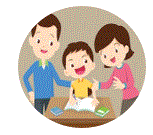You can never help too much with Mathematics and practicing at home is a great way to embed children's knowledge, enabling them to master their learning. A great way to engage children at home with Maths is to play games. Matching pairs, snap, sorting numbers or quick fire can all be ways to help teach your children and you can do it almost anywhere: walking to school, driving in the car, while you are shopping or just in the house.
When counting, encourage your child to point to each object, putting them in a row. Practise counting in twos, fives or tens using, for example, pairs of socks, fingers on hands or 10p coins.
Gather some objects – blocks, buttons, even biscuits! Roll two dice and find the total, using the objects to add practically. Or start with, say, 12 objects, roll a dice and subtract the number shown on the dice to find how many objects are left. The player with more objects wins.
Explore fractions using some of your child’s favourite toys, for example teddies or cars. Ask your child to halve their toys by splitting them into two equal groups. So, for ten cars, make two groups of five. Similarly, practise finding one quarter by splitting toys into four equal groups.
Partitioning means to break numbers into parts. Use objects, such as straws grouped in tens, to show numbers split into tens and ones. How many ways can your child find to partition a number? For example, 54 could be 50 + 4, 40 + 14, 30 + 24, 20 + 34, or 10 + 44.
Make up addition and subtraction stories together. For example: Two badgers, three hedgehogs and a toad have a picnic. How many animals are there altogether? Four rabbits join in. How many are there now? Two animals go home. How many are left?
To help your child get used to the value of different coins and notes, use real money to play shops. Children having interaction with real coins and notes and having their value reiterated will really help their understanding of number. Price up some toys and take turns to be the customer who pays and the shopkeeper who works out the change.
Arrays are shapes or objects arranged in a rectangle, such as a muffin tray or an egg box. Give your child some counters, buttons or beads, say 12. How many different arrays can they make? What calculations does each array show?
Use foods with a regular shape (cake, pizza, cucumber slices) and ask questions like: Let’s cut this into 8 pieces, what fraction is each piece? Find fractions of amounts using foods such as fishfingers or biscuits: There are 12 in the packet and 4 of us. What fraction can we each have? How many each is that?
Hide some ‘treasure’ in a room and blindfold your child. Give them directions to find the treasure, such as: Turn two right angles clockwise, now take three steps forward. Use whole, half, quarter and three-quarter turns clockwise and anti-clockwise.
Look for negative numbers to discuss with your child. For example, thermometers, weather reports, storage temperatures on frozen food packets, elevation of places below sea level, goal differences in sports league tables, below-ground floors in lifts, losing points in video games.
Make two sets of number cards 1–12. Shuffle and place them face down in two piles. Take a number from each pile and multiply them together. Score a point for each correct answer. The first to 10 points wins.
Practise rounding decimals with one decimal place to the nearest whole number when shopping. Challenge your child to round prices to the nearest pound. For example, an item costing £4·70 would be £5 to the nearest pound.
Most interactive activities are arranged into year groups or ages so it may be a good idea to find out from your class teacher what year group or age range your child is currently working at. If you have a computer, tablet or even a phone with access to the internet at home, then below is a list of websites that have fun interactive games for children to play.
Top tips for parents and families
Be positive about maths. Don't say things like "I can’t do maths" or "I hated maths at school"; your child might start to think like that themselves.
Point out the maths in everyday life. Include your child in activities involving maths such as using money, cooking and travelling.
Praise your child for effort rather than talent - this shows them that by working hard they can always improve.



